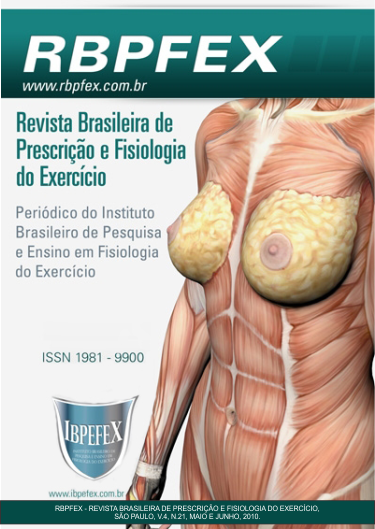Incidences of injuries in professionals of physical education who administer classrooms in academies: a perspective of the disturbances osteomusculares made a list to the work charge
Abstract
Every physical activity demands a certain amount of physical effort in order to be executed and the same rule applies to the professional of physical education from whom the invested effort many times goes beyond his or her level of preparation. This study’s goal is to verify the injuries that these professionals suffer while working according to their assign-ment in gymnasiums. With the cooperation of Physiology students from UGFa research composed of twelve questions allowed us to collect enough information to support the subject being studied and this research took place in the cities of Curitiba, Imbituva and Ponta Grossa involving fifty-three PE professionals, where 29 of them were males and 24 females were females with an average age between twenty-one and forty-two years old. The high rate of 96% of professionals suffered injuries when were submitted to extensive hours of continuous work loads throughout the day. The most frequently injuries were reported to have occurred in the knees, ankles, lumbar region of the vertebrae column and hips. The other discovery was that 71.2% of the injured did not stop or interrupted they work routine while still injured. Another important finding of the research was that 46.2% of the interviewed professionals perform physical activity throughout the whole duration of the class, and although the difference was slim, the collected data showed that men get injured more that women do, and the age rate more affected is between twenty-one and twenty-five years old for both genders.
References
-Andreoli, C.V.; Wajchenberg, M.; Perroni, L. Lesões nos esportes -diagnóstico, prevenção e tratamento. São Paulo. Revinter. 2003. p. 124-132.
-Arendt, H. A Condição Humana. São Paulo. Forense Universitária. 2000. p. 47-53.
-Bordo, S.R. O Corpo e a reprodução da feminidade: uma apropriação feminista de Focault. Rio de Janeiro. Record. 1997.
-Carazzatto, J.G. Lesões musculotendinea e o seu tratamento. Revista Brasileira de Ortopedia e Traumatologia. Rio de Janeiro. Vol. 29. Num 10. 1994.
-Carvalho, Y.M.O Mito atividade física/saúde: Dissertação de mestrado. Faculdade de Educação Física. Unicamp. São Paulo. 1993.
-Charlton, S.G. Handbook of Human Factors Testing and Evaluation. New Jersey. Mahwah.1996.
-Cooper, K.H. Programa aeróbico para o bem estar total. Rio de Janeiro. Nórdica. 1982.
-Daolio, J. Da Cultura do corpo. Campinas. Papirus. 1995.
-Gaezel, R.M. Manual de fisioterapia. São Paulo. Sprint. 2001.
-Greco, R.M.; Oliveira, V.M.; Gomes, J.R. Cargas de trabalho dos técnicos operacionais da escola de enfermagem da Universidade de São Paulo. Revista Brasileira de Saúde Ocupacional. Vol.25. 1996.p.59-75.
-Laurell, A.C.; Noriega, M. Processo de Produção e Saúde. Trabalho e Desgaste Operário. São Paulo. Cebes-hucitec. 1989.
-Laville, A. Ergonomia. São Paulo. Editora da Universidade de São Paulo. 1977.
-McArdle, W.D.; Katch, F.I.; Katch, V.L. Fisiologia humana –energia, nutrição e desempenho humano. Rio de Janeiro. Guanabara Koogan. 1998.
-Moura, W. Trabalho e doença existencial: Uma visão Psicosociológica das Doenças Ocupacionais. UFRJ. Rio de Janeiro. 1998.
-Oliveira, A.A.B. Critical analysis of the curriculum of practical disciplines of the Physical Education course from the Universidade Estadual de Maringá. Revista da Educação Física. Universidade Estadual de Maringá. Vol.0. Num1. 1990.p. 17-25.
-Roberts, M. 90-day Fitness Plan. São Paulo. Globo. 2001.
-Rodrigues, F.R. O Ensino e a prática da Educação Física. São Paulo. Cortez. 1982.
-Saltin, B. Anaerobic capacity: past, present and prospective: Biochemestry of exercise. Champaign, Human Kinetics. Vol. 3. 1990.
-Silva, K.R. Análise de fatores ergonômicos: Dissertação de mestrado. Universidade Federal de Viçosa. Minas Gerais. 1999.
-Tavares, J. A. Revista Isto É. São Paulo. Num. 1812. Junho/2004.
-Torres, M. R. Corpos sob medida. São Paulo. Ed. Abril. 1995.
-Verdussem, R. Ergonomia e racionalização humanizada no trabalho. Rio de Janeiro. LTC. 1978.
-Wisner, A. A inteligência no trabalho: textos selecionados de ergonomia. São Paulo. Fundacentro. 1997.
Authors who publish in this journal agree to the following terms:
- Authors retain the copyright and grant the journal the right of first publication, with work simultaneously licensed under the Creative Commons Attribution License BY-NC which allows the sharing of the work with acknowledgment of the authorship of the work and initial publication in this journal.
- Authors are authorized to enter into additional contracts separately for non-exclusive distribution of the version of the work published in this journal (eg, publishing in institutional repository or book chapter), with acknowledgment of authorship and initial publication in this journal.
- Authors are allowed and encouraged to post and distribute their work online (eg, in institutional repositories or on their personal page) at any point before or during the editorial process, as this can bring about productive change as well as increase impact and impact. citation of published work (See The Effect of Free Access).






